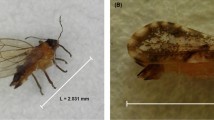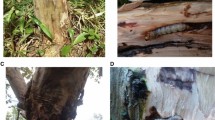Abstract
Teleonemia scrupulosa (Stål) (Hemiptera, Tingidae) is a native of the tropical regions of the Americas and has been extensively used as an agent for the biological control of the noxious weed Lantana camara Linn. (Verbenaceae). It was introduced first into Hawaii1; since then it has been introduced into Fiji2, Australia3, Indonesia4 and other island groups in the Pacific. It is also established in India5, Mauritius, and South6, Central7 and East Africa. In general the level of control achieved in these areas has been disappointing, although severe local defoliation and partial control has been reported from many of these countries, and it is generally considered to be a useful addition to the insect complex used in the control of Lantana. Exhaustive tests in Fiji and Australia showed that this Tingid would feed on none of the plants tested except Lantana8. The bug was reported in Texas on Callirhoe involucrata (Malvaceae) and a plant of the mint family but was unable to breed or live long on them9. Its release in India was not recommended because laboratory tests showed that it could feed on teak (Tectonagrandis Linn.) which is also a member of the Verbenaceae although breeding was slow and Lantana was preferred10. When it escaped at Dehra Dun, however, it became established on Lantana but could not be found on nearby teak5. The only other previous records of attack by T. scrupulosa on other plants are its occurrence on Myoporum sandwicensis (Myoporaceae) and species of Xanthium (Compositae) in Hawaii, ebony in the United States, and Lippia alba (Verbenaceae) in the Antilles, according to the catalogue just published, which includes some hitherto overlooked records11.
This is a preview of subscription content, access via your institution
Access options
Subscribe to this journal
Receive 51 print issues and online access
$199.00 per year
only $3.90 per issue
Buy this article
- Purchase on Springer Link
- Instant access to full article PDF
Prices may be subject to local taxes which are calculated during checkout
Similar content being viewed by others
References
Perkins, R. C. L., and Swezey, O. H., Bull. Exp. Sta. Hawaiian Sug. Pl. Ass. Ent. Ser., No. 16 (1924).
Simmonds, H. W., Agric. J. Fiji, 2, 36 (1929).
Wilson, F., Commonwealth Inst. Biol. Contr. Tech. Commun., No. 1 (1960).
Van der Vecht, J., Tijdschr. Pl. Ziekt, 59, 170 (1953).
Roonwal, M. L., J. Zool. Soc. Ind., 4, 1 (1952).
Oosthuizen, M. J., J. Ent. Soc. S. Africa, 27, 3 (1964).
Whellan, J. A., Rep. Sec. Fed. Min. Agric. for the year ended 30th September 1961, 64 (1962).
Fyfe, R. V. J., Coun. Sci. Indust. Res. Austral., 10, 181 (1937).
Drake, C. J., and Frick, D. M., Proc. Hawaii Ent. Soc., 10, 199 (1939).
Gardner, J. C. M., Ind. For., 70, 139 (1944).
Drake, C. J., and Ruhoff, F. A., Bull. U.S. Nat. Mus., 243 (1965).
Le Pelley, R. H., Agricultural Insects of East Africa (Nairobi, 1959).
Author information
Authors and Affiliations
Rights and permissions
About this article
Cite this article
DAVIES, J., GREATHEAD, D. Occurrence of Teleonemia scrupulosa on Sesamum indicum Linn. in Uganda. Nature 213, 102–103 (1967). https://doi.org/10.1038/213102b0
Issue Date:
DOI: https://doi.org/10.1038/213102b0
This article is cited by
-
Biological control of weeds with insects: A dynamic phenomenon of insect-plant interaction
Proceedings: Animal Sciences (1990)
-
Tingidae for biological control ofLantana camara [Verbenaceae]
Entomophaga (1971)
Comments
By submitting a comment you agree to abide by our Terms and Community Guidelines. If you find something abusive or that does not comply with our terms or guidelines please flag it as inappropriate.



